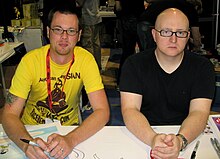History of webcomics
The history of
In the second half of the 2000s, webcomics became less financially sustainable due to the rise of social media and consumers' disinterest in certain kinds of merchandise. However, crowdsourcing through Kickstarter and Patreon also became popular in this period, allowing readers to donate money to webcomic creators directly. The 2010s also saw the rise of webtoons in South Korea, where the form has become very prominent.
Early history (1985–1995)
The earliest comic distributed on the Internet is
From the 1980s to the early 1990s, artists published using many different
In 1994 and 1995, webcomics such as Jax & Co.,
The second decade (1995–2005)
In 2000,
In 1997, Bryan McNett started a webcomic hosting provider, calling it Big Panda. Over 770 webcomics were hosted on Big Panda, including
In 2002, Joey Manley started webcomic portal Modern Tales as a competitor to Keenspot, which became one of the first profitable subscription models for webcomics. According to T Campbell, webcomics seemed unsustainable at the time, with advertisement rates dropping to an all-time low. Manley's Modern Tales was a popular solution at the time, and Manley spun off websites such as Girlamatic and Webcomics Nation.[14] Modern Tales had 2,000 members by 2005, each paying US$3 per month. In the same year, Keenspot drew in around 125,000 readers per day, grossing over US$200,000 per year through advertising.[15] Established comic artists such as Carla Speed McNeil and Lea Hernandez found themselves moving towards the Internet in order to reach larger audiences and build "online portfolios".[13]
With the proliferation of webcomics,
Video game webcomics

The second half of the 1990s saw the introduction of
Penny Arcade also proved to be a huge player in fields outside of webcomics in the early 2000s. In 2003, Holkins and Krahulik founded
David Anez' Bob and George, which launched in April 2000, was the first sprite comic to reach a larger level of popularity. However, it wouldn't be until the release of Brian Clevinger's 8-Bit Theater that the genre really took off. Maragos of 1-UP.com stated that 8-Bit Theater "took the style to its fullest expression and greatest popularity."[20] Larry Cruz of Comic Book Resources pointed out that, though sprite comics are still an overwhelmingly popular style, "no other sprite comic [has] really achieve[d] the same amount of popularity" since 8-Bit Theater's discontinuation in 2010.[21]
Recent history (2005–present)
Bradly Dale from
Though the
My business is not a business in the sense of being a small and medium sized enterprise or even particularly entrepreneurial ... I make comics because I like the activity of writing and drawing. It is a self-sustaining, one-man enterprise.
Scary Go Round-creator John Allison[23]
With the rise of social media in the second half of the 2000s, webcomic artist began having a more difficult time gaining attention and views. Wondermark-creator David Malki believes traffic to webcomic websites plateaued in 2012, as visiting content-specific websites generally disappeared from people's daily routines. Sharing of comic strips on social media such as Facebook has led to more exposure of webcomics, causing some to show signs of growth, but few people access webcomic websites directly.[24]
In 2015, Gambrell stated that "webcomics are dead," as the period of webcomics only being posted for free on the internet was over and the industry had moved beyond the internet.[23] Though many successful webcomic creators in the 2010s do not envision their online craft as their "job", most do not have to worry about basic money issues.[23] However, Sarah Dorchak of Gauntlet proposed in 2011 that the free nature of webcomics may be a leading factor in the decline of economic viability of traditional comic books.[1]
Crowdsourcing

In 2004, R.K. Milholland's started a
Another large shift in the webcomic industry came with the 2013 introduction of
Asian webcomics
The early 2010s saw the global increase in popularity of
Around the same period,
See also
References
- ^ a b Dochak, Sarah (2011-11-29). "Pioneering the page: The decline of print comics, the growth of webcomics and the flexibility, innovation and controversy of both". Gauntlet. Archived from the original on 2015-12-22.
- ^ Smith, Alexander, K. (2011-11-19). "14 Awesome Webcomics To Distract You From Getting Things Done". Paste.
{{cite magazine}}: CS1 maint: multiple names: authors list (link) - ^ Joe Ekaitis (1994-12-04). "Meet Joe Ekaitis — T.H.E. FOX" (Interview). Interviewed by Sherry, accompanied by Lou Schonder.
- OCLC 17565429.
- ^ Campbell (2006). pp. 10–13.
- ^ a b c Atchison (2008). part one
- ^ a b Garrity, Shaenon (2011-07-15). "The History of Webcomics". The Comics Journal.
- ^ a b Campbell (2006). pp. 18–19.
- ^ Campbell (2006). p. 10.
- ISBN 978-0262015011.
- ^ Meginnis, Mike (2005). The Artistic History of Webcomics. "Scott Adams".
- ^ Boxer, Sarah (2005-08-17). "Comics Escape a Paper Box, and Electronic Questions Pop Out". The New York Times.
- ^ a b Atchison (2008). part two
- ^ Melrose, Kevin (2013-11-08). "Modern Tales founder Joey Manley passes away". Comic Book Resources.
- ^ Walker, Leslie (2005-06-16). "Comics Looking to Spread A Little Laughter on the Web". The Washington Post.
- ^ Maragos (2005). p. 1.
- ^ a b Maragos (2005). p. 4.
- ^ Meginnis, Mike (2005). The Artistic History of Webcomics. "Tycho and Gabe".
- ^ Atchison (2008). part three
- ^ Maragos (2005). p. 3.
- ^ Cruz, Larry (2014-05-09). "Will there ever be another great sprite comic?". Comic Book Resources.
- ^ a b c Dale, Bradly (2015-11-16). "The Webcomics Business Is Moving on From Webcomics". The New York Observer.
- ^ a b c d Dale, Bradly (2015-11-19). "Lessons in Creativity From Successful Webcomic Artists". The New York Observer.
- ^ Dale, Bradly (2015-11-18). "The Changing Internet Through Webcomics". The New York Observer.
- ^ Dale, Bradly (2015-11-17). "Patreon, Webcomics and Getting By". The New York Observer.
- ^ McMillan, Graeme (2012-09-06). "'Homestuck' heads towards new Kickstarter record". Digital Trends. Retrieved 2013-05-29.
- The Huffington Post.
- ^ "South Korean 'webtoon' craze makes global waves". The Japan Times. 2015-11-26.
- ^ Lee, Jun-Youb (2015-04-03). "Startup Battles Naver in English Webtoons". The Wall Street Journal.
- ^ Verma, Tarishi (2015-04-26). "Laughing through our worries: The Indian web comics". Hindustan Times.
- npr.org.
Bibliography
- Campbell, T. (2006-06-08). A History of Webcomics. ISBN 0976804395.
- Atchison, Lee (2008-01-07). "A Brief History of Webcomics — The Third Age of Webcomics". Sequential Tart.
- Maragos, Nick (2005-11-07). "Will Strip for Games". 1UP. Archived from the originalon 2015-12-08.
- Various (2005). "The Artistic History of Webcomics – A Webcomics Examiner Roundtable". The Webcomics Examiner. Archived from the originalon 2005-11-24.
